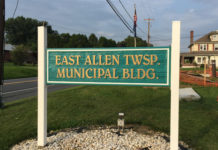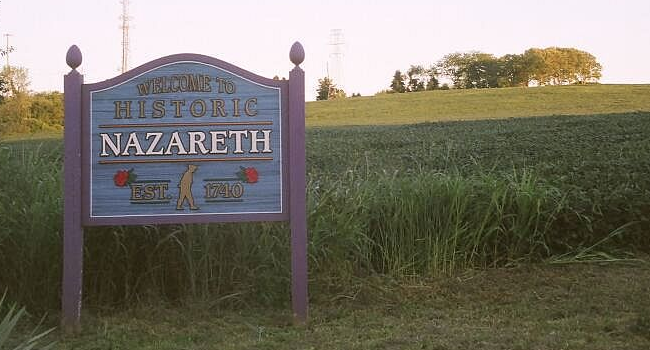The Lehigh Township Zoning Hearing Board met Thursday, August 24 during a six-hour meeting for the consideration of three special exception use applications for the construction of a medical marijuana campus and separate fast-food restaurant on a vacant lot along Birch Drive currently owned by the LURRS partnership.
President of Lehigh Engineering Associates, LURRS partner and applicant Mark Leuthe’s proposed development, which he termed “medical marijuana campus,” consisted of a 33-acre parcel with 18 lots subdivided into 16 medical marijuana grower/processor facilities, a 3,000-square-foot medical marijuana dispensary, and a separate drive-through and fast-food restaurant at the corner of Birch Drive and Riverview Drive.
Leuthe, represented by attorney Kevin T. Fogerty, testified on behalf of the LURRS partnership that the proposed developments complied with all township requirements for special exception permitted use and if granted the special exceptions he sought, he would comply with township zoning and land use requirements during the subdivision and land development process, as well as with state level requirements set forth by the Pa. Department of Health.
Leuthe testified that the facilities would have a “laundry list” of security measures to deter and prevent theft, have adequate fencing and buffer plantings to reduce public view and would not amass large amounts of traffic to the area.
Additionally, Leuthe testified that he would be agreeable to a condition being imposed that would require the installation of a filtration system that mitigates odors and fumes in each of the buildings to ensure that no vapors, odors or fumes escape the building in adherence of the township’s ordinance.
President Marc Byers of Byers Scientific, a manufacturing company specializing in industrial odor mitigation and cannabis cultivation, testified that the equipment his company provides emits a level of zero odors detectable outside of the buildings if the equipment is properly installed and maintained and has a 100% success rate.
“We design our system to ensure that there should be no fugitive odors at the property line,” Byers stated.
However, during cross-examination, solicitor David M. Backenstoe pointed out a caveat in Byers’ testimony that if the customer doesn’t follow the remediation measures, then odor may escape the facility and presumably affect the community.
Byers asserted that this hypothetical situation has never happened and that if customers elect to not comply with their service and maintenance contract, then that would create a legal issue.
Backenstoe raised several concerns related to LURRS’ application throughout the meeting, including the fact that they only filed three special exception use applications for the drive-through restaurant, the medical marijuana dispensary and the 16 grower/processor facilities.
First, the application listed the facilities as a “medical marijuana campus,” which Backenstoe argued is not listed as a permitted special exception use under the zoning ordinance. However, Leuthe posited that medical marijuana campus was simply the name plate he coined the development as.
Second, Backenstoe argued that each of the 16 proposed grower/processor facilities should have been filed as 16 separate special exception applications because there are 16 separate lots, but they were all grouped into one application. Leuthe maintained that the special exception use is the same for all 16 buildings, which is why he did not believe filing separate applications for each one was necessary.
Third, Backenstoe presented another discrepancy in the application regarding the square footage of the grower/processor facilities, which was listed as 16 20,000-square-foot maximum facilities with an overall square footage of roughly 280,000. By that math, Backenstoe pointed out that the total would be 320,000.
Leuthe clarified that the buildings range in size from 15,000 square feet to 19,950 square feet due to the maximum floor area of medical marijuana grower/processor facilities in the zoning ordinance being 20,000 square feet.
However, Backenstoe contended that 280,000 square feet is not permitted by the ordinance, which states that maximum floor area of a grower/processor facility is limited to 20,000 square feet, and if he is combining all 16 facilities on one application, then he would need to have also filed for a variance since he did not file separate applications for each proposed building and its respective size.
Additionally, both the zoning ordinance and state law set forth that a dispensary may not operate on the same site as a facility used for growing and processing and must be a minimum of 1,000 feet from the nearest medical marijuana dispensary, to which Fogerty argued was not applicable because each facility would be on its own separate lot.
Another concern raised by Backenstoe was the traffic analysis that the applicant provided.
Lehigh Engineering Traffic Technician Jason Scott testified that he performed a traffic analysis for the proposed development using a program called the Institute of Traffic Engineers that PennDOT also uses. The program generates what the predicted traffic of a particular use or development will be based on land use group, retail commercial services, and land use respective to the development’s square footage.
Scott explained that this is typically the starting point for a traffic analysis study, which is later refined during the subdivision and land development process to determine whether there needs to be any improvements or changes to the existing roadways.
Backenstoe established that the traffic analysis Scott prepared was not a formal traffic study, which makes the figures he provided for projected traffic an informal statement, which would not fulfill the requirement of the zoning ordinance for the applicant to provide a written study with the project description.
Fogerty retorted that the specific special exception uses LURRS is pursuing do not require a traffic impact study at this time; however, Backenstoe argued that the zoning ordinance mandates that a traffic study be submitted at the same time as a special exception use application.
During questioning and comments, residents passionately expressed consensus that the proposed medical marijuana campus was unwanted based on how it would negatively affect the community and their quality of life in a multitude of ways.
After hearing each party’s closing arguments, the Lehigh Township Zoning Hearing Board rejected LURRS’ special exception use application for the 16 medical marijuana grower/processor facilities in a unanimous vote of 5-0.
The board also denied the proposed medical marijuana dispensary in a majority vote of 3-2.
Last, the board unanimously voted to accept LURRS’ application for a drive-through fast-food restaurant at the corner of Birch Drive and Riverview Drive.








